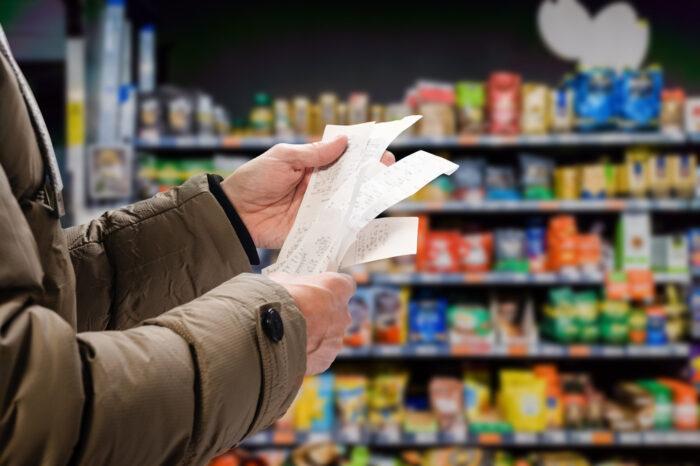Grocery price inflation has fallen eight times in a row to finally hit single digits for the first time since July 2022.
In the four weeks to 29 October 2023, grocery price inflation dropped to 9.7%, “marking a big milestone for the British public and retailers”, according to analysts Kantar.
While this is good news, shoppers are still feeling the pinch, so it’s no surprise that the proportion spent on promotions has increased while buyers continue to trade down on items to help manage budgets.
Kantar revealed that consumer spending on promotions has now hit 27.2% of total grocery sales which is the highest level seen since Christmas last year. Compared to the same period last year, this figure was less than a quarter.
It said every single one of the grocers increased the proportion of sales through deals versus last year which is something that has only happened on one other occasion in nearly a decade.
Own label vs branded items
Meanwhile, own label lines have grown ahead of their branded counterparts every month since February 2022, as these lines were boosted 8% during the latest period.
This means that the gap between own label and branded goods is now at its narrowest level since spring last year, with branded items recording a 6.7% increase in the latest month.
But Kantar said this may change in the run up to Christmas as shoppers “typically turn more to brands”.
Despite the promising news for shoppers that food inflation is in decline, the reduction in prices compared to last year was still limited to a few food categories. Much like in September, the only items to fall in price compared to 2022 were butter, dried pasta and milk.
But for those looking to get into the festive spirit early, the average price of a bottle of sparkling wine fell from £7.46 in August to £6.86 last month. However, the price of low-alcohol beer has risen more quickly but sales rose 16% compared to last year, with Sober October cited as a contributing factor.
Shoppers flock to budget retailers
When it comes to where shoppers are spending their cash, budget chains experienced another strong month. Lidl saw the fastest growth out of all the retailers, with sales up 14.7% over twelve weeks. Just recently it pipped Aldi to be crowned the cheapest supermarket for a basket of popular goods, breaking Aldi’s 16-month run. Rival retailer Aldi increased its number of shoppers by 207,000 compared to 2022 and was only joined by Waitrose in stores that had a year-on-year rise in customers.
Kantar noted that more than half of Aldi and Lidl sales come from the more affluent social groups.
Fraser McKevitt, head of retail and consumer insight at Kantar, said: “Discounters are making their mark in frozen items and fresh groceries like meat and veg, with these categories constituting a higher proportion of their sales than the traditional retailers.”
He added: “While the drop to 9.7% is positive news and something of a watershed, consumers will still be feeling the pinch. It’s now been over a year and a half of pinched pockets and people are continuing to respond by trading down on the items they’re putting into their baskets.”
On the upcoming festive period, McKevitt said: “The fight for shoppers’ Christmas spend looks set to be fierce between the retailers this year. When it comes to where people shop, Brits definitely aren’t loyal and some of the traditional shopping demographics and stereotypes have been thrown out of the window.”
‘Psychological milestone’ for households
Myron Jobson, senior personal finance analyst at Interactive Investor, said: “Food inflation easing back to a single digit level is a psychological milestone that will make many Britons feel good about where prices are heading. Britons have been force fed a diet of higher costs for basic necessities for a prolonged period. The fact that we’re seeing some easing in food inflation is really important for shoppers.
“Despite the relief in food price growth, costs are still much higher than they were before the pandemic. They remain uncomfortably high for many, especially for those on a low-income who spend a greater share of their money on food.”
Jobson added: “More broadly, shop prices are taking a bigger slice of household budgets. Some households are managing to shoulder the pain of higher prices – in part because of the wage growth run. But not every worker will have had a pay rise, and the inflation burden continues to weigh heavy on many household finances.”

